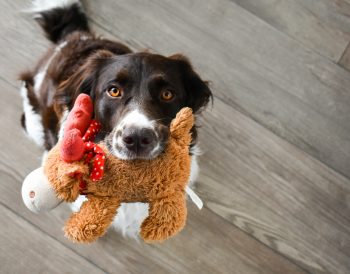When expressing emotions, dogs are surprisingly adept at communicating their feelings, including remorse, to their human companions. Whether chewed up a favourite pair of shoes or knocked over a vase, dogs often exhibit behaviours that suggest they’re aware they’ve crossed a line and wish to make amends. These expressions of apology are not rooted in a human understanding of right and wrong. Still, they are instead a complex mixture of canine social behaviours and their deep-seated desire to maintain harmony within their pack, which now includes humans. Understanding how dogs show they’re sorry deepens our comprehension of dog psychology and enhances the bond between dogs and their owners, allowing for more effective communication and resolution of conflicts. These behaviours, ranging from subtle body language to more overt actions, are dogs’ ways of expressing regret and seeking reconciliation with their human family.
1. Submissive Postures
One of the most common ways dogs show remorse is through submissive postures. A dog might lower its body or head, avoid direct eye contact, or expose its belly. These postures are deeply ingrained in canine social behaviour, signalling that they acknowledge their mistake and wish to submit to their owner’s authority. This behaviour is rooted in the pack dynamics from which domestic dogs evolved, where showing submission could alleviate tension and restore peace within the group. When a dog adopts these postures in response to scolding or after misbehaving, it’s their way of saying they’re sorry and seeking forgiveness, hoping to appease any upset feelings and reestablish a peaceful state in the household.
2. Licking and Nuzzling
Licking and nuzzling are other behaviours dogs use to express apology and repentance. These actions are comforting gestures that dogs often use to show affection and make amends. By gently licking or nuzzling their owner, a dog attempts to soothe and reassure, demonstrating their desire to mend the bond they fear may have been damaged by their actions. This behaviour can be seen as an extension of the grooming and bonding activities occurring naturally within canine social structures, adapted to human interactions. It’s a dog’s way of reducing tension and showing affection, reinforcing their loyalty and love for their owner despite the mishap.
3. Bringing Toys or Gifts
Some dogs may bring toys or other items to their owners as a way of apologizing. This behaviour can be interpreted as a peace offering, an attempt to distract or please their human companion after a transgression. Bringing a favourite toy or even a random object they find can be a dog’s method of making amends, hoping to elicit a positive response and possibly divert attention from their wrongdoing. This gesture is akin to reparative behaviour, where the dog seeks to contribute positively to the relationship, offering something they value in the hope of forgiveness and a return to normalcy.
4. Tail Wagging and Ears Back
A dog showing remorse might also display a combination of tail wagging and ears pinned back. This body language is nuanced; the tail wagging is not the exuberant, full-body wag associated with happiness but a lower, slower wag that conveys a more subdued emotion. Ears pinned back against the head further indicate the dog’s unease and desire to appease. This combination signals a dog’s acknowledgment of their misbehaviour and their wish to convey regret. It’s a visual cue to their owners that they understand the gravity of their actions and seek a way to communicate their apology, striving to lighten the mood and soften their response.
5. Avoidance Behavior
Avoidance behaviour is another way dogs may show they’re sorry, mainly if they sense their owner’s displeasure. A dog might retreat to a corner, avoid making eye contact, or even hide under furniture. While this behaviour may seem like guilt or shame, it’s more accurately a dog’s response to the negative emotions they perceive from their owner. By removing themselves from the situation, they attempt to de-escalate the tension and show their understanding that they’ve done something undesirable. This behaviour reflects their sensitivity to their social environment and desire to restore harmony, even if it means withdrawing to allow emotions to cool.
Dogs can remarkably communicate their emotions and intentions, including remorse. Through submissive postures, licking and nuzzling, bringing toys or gifts, tail wagging with ears back, and avoidance behaviour, dogs express their apologies in ways deeply rooted in their social behaviours and relationships with humans. Recognizing and understanding these behaviours can help strengthen the bond between dogs and their owners, fostering a more profound empathy and improving communication. By acknowledging and responding to these gestures of contrition, owners can reassure their dogs, mend the relationship after misunderstandings, and reinforce the loving bond that makes the human-canine relationship unique.
The post 5 Ways Dogs Show They’re Sorry appeared first on iHeartDogs.com.

